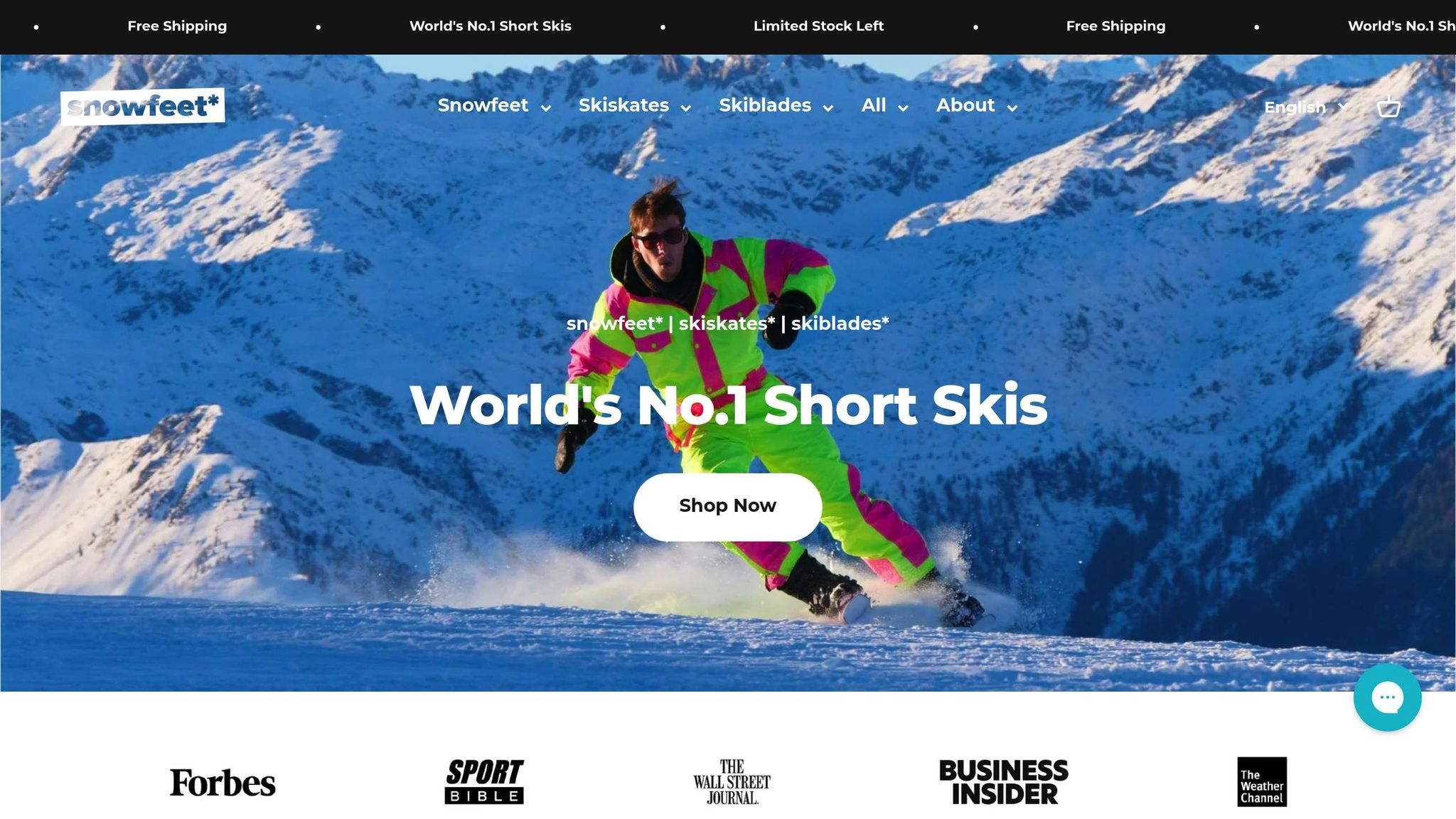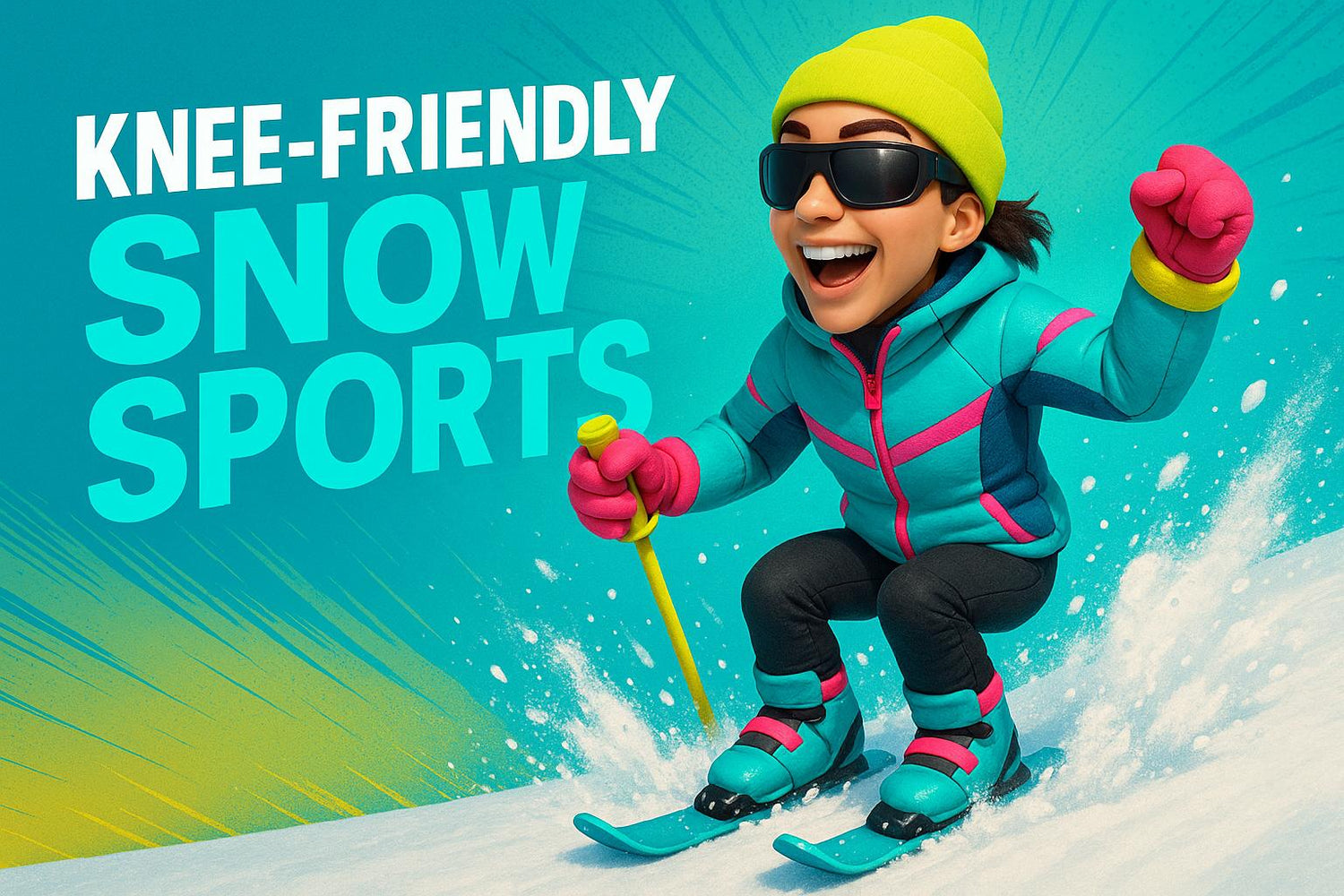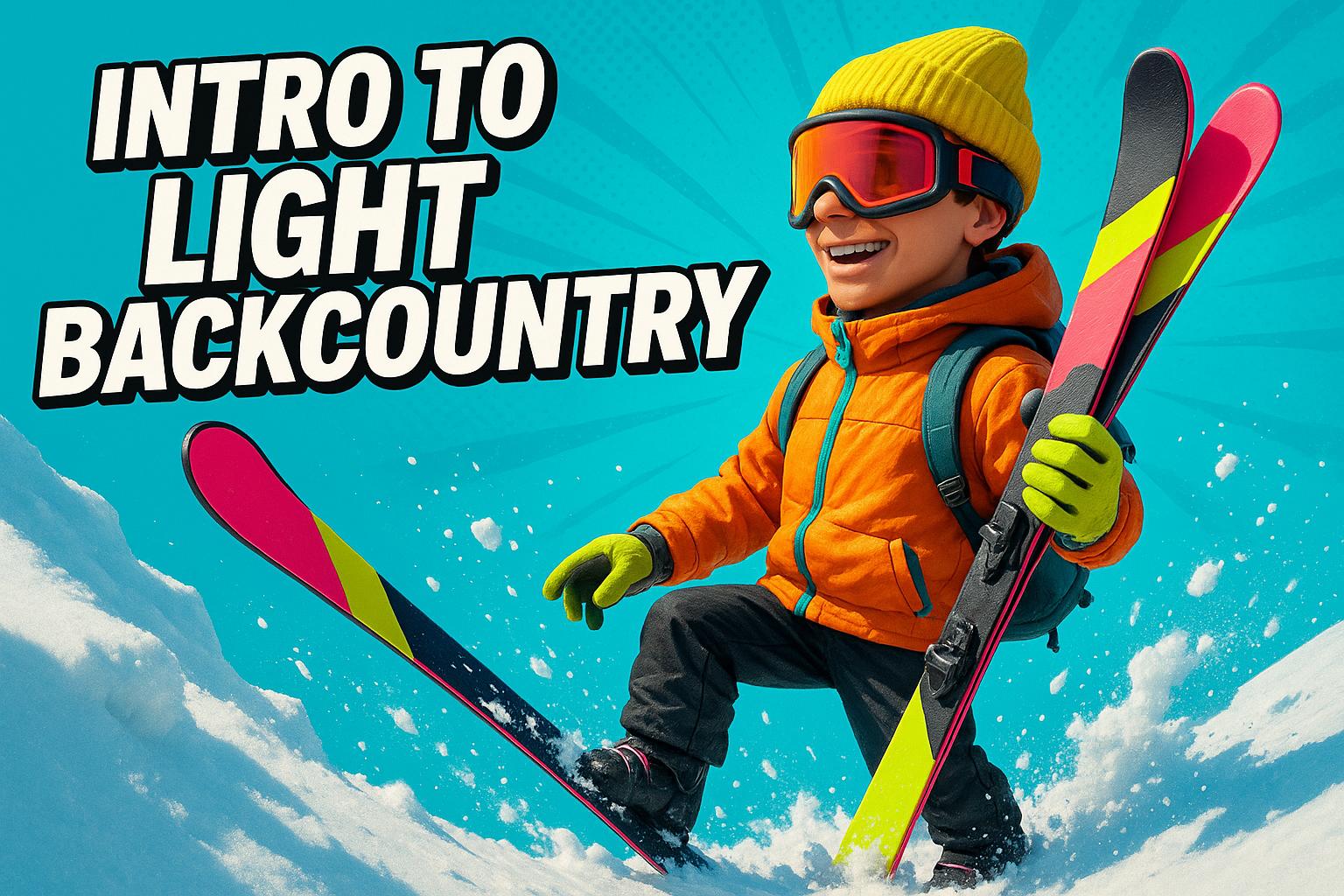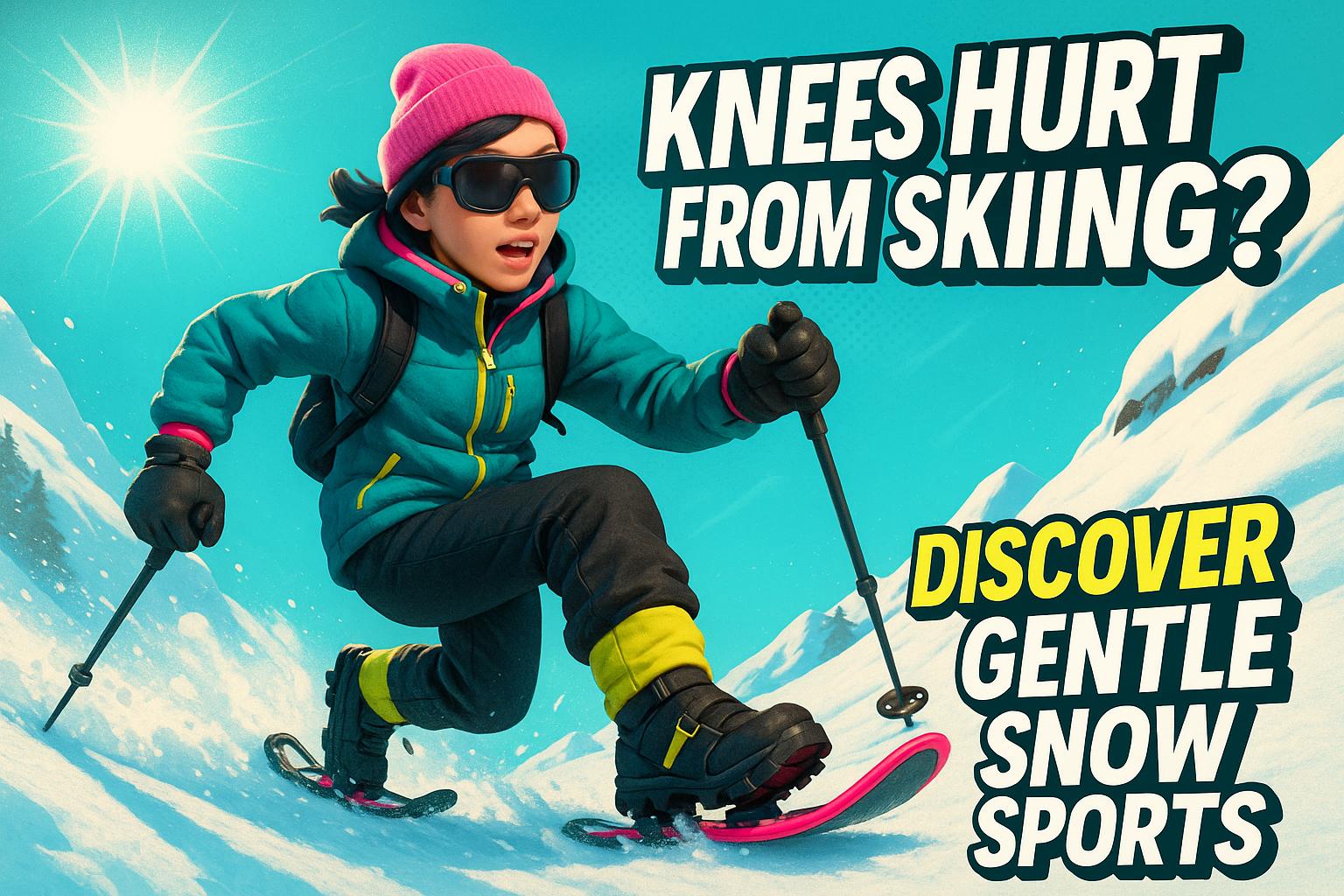膝の痛みなくスキーやスノーボードを楽しみたいですか?伝統的なギアに代わる画期的なSnowfeetをご紹介します。膝に優しい理由はこちらです:
- 短いスキーで負担軽減:Snowfeetの44~120cmのスキーは、通常の150~200cm以上のスキーに比べて膝へのねじれ力を最小限に抑えます。
- 軽量設計:1本あたり2ポンド未満のSnowfeetギアは操作が簡単で関節への負担を軽減します。
- 硬いスキーブーツは不要:Snowfeetは通常の冬用ブーツやスノーボードブーツで使え、快適さとアライメントを向上させます。
- 手頃な価格オプション:価格は140ドルからで、多くのウィンタースポーツ愛好者に手が届きやすくなっています。
重要な理由:伝統的な長いスキーと硬いブーツは膝に過度の圧力をかけ、痛みや怪我のリスクを高めます。Snowfeetのコンパクトで軽量なデザインはその負担を軽減し、安心してゲレンデを楽しめるようにします。
| 特徴 | Snowfeet Skiblades(99 cm) | 伝統的なスキー(150~200+ cm) |
|---|---|---|
| 長さ | 99 cm | 150~200+ cm |
| 1本あたりの重量 | 2ポンド未満 | はるかに重い |
| ターン半径 | 6 m | 大きい |
| 膝への負担 | 最小限 | 高い |
| 操作性 | 優秀 | より多くの努力が必要 |
結論:Snowfeetは膝に優しく、軽量で多用途な伝統的なスキーギアの代替品を提供し、冬のスポーツを誰でも楽しめるものにします。
ACL断裂を防ぐためのスキーヤー向け筋力トレーニング
なぜ一般的なスノースポーツは膝を痛めるのか
ゲレンデに出ることは膝にとって厳しいことがあります。スキーでもスノーボードでも、装備の設計とこれらのスポーツの身体的要求が関節に大きな圧力をかけます。
長いスキーとスノーボードが膝に与える負担
膝の負担の主な原因の一つは、伝統的なスキーやスノーボードの長さです。特にRossignolやAtomicのようなブランドのスキーは長いレバーのように働き、ターンを切る際に膝への力を増大させます。ターンが鋭く速ければ速いほど、膝へのストレスは大きくなります。
"スキーが長いため、ねじれが膝に大きなトルクをかけ、その物理的な力が多くのスキーによる膝の怪我に関与しています。" - マイケル・コロスキー医師、Mass General Brighamスポーツ医学提供者兼整形外科医
HeadやElanのようなより長いスキーはこの影響を増幅し、膝にさらに大きな負担をかけます。
スノーボードは異なりますが、膝に優しいわけではありません。このスポーツはバランスとコントロールを保つために常に膝を曲げて安定させることを要求します。ジャンプの着地や不均一な地形を走る際の繰り返される衝撃が加わると、その負担は明らかです。数字もそれを裏付けています:スノーボードの怪我の70%以上がリードレッグに発生し、膝の怪我は手首の怪我に次いで2番目に多いタイプです。
スキーとスノーボードの両方に関わる反復動作は、時間とともに膝に累積的なストレスをもたらす可能性があります。
"スキーほど膝の前部や膝蓋腱に負荷をかけるものはありません。1日に何時間も膝を曲げた状態で、モーグルや凸凹、着地の衝撃を吸収しながら、何百回もねじったり、回したり、曲げたり、伸ばしたりすることが他にありますか?" - ケビン・R・ストーン医師、整形外科医
原因は装備の長さだけではありません。ブーツやアライメントの問題も大きな役割を果たしています。
硬いブーツと悪いアライメントの問題
伝統的なスキーブーツは必須ですが、膝にリスクをもたらすアライメントの問題を引き起こすことがあります。その硬い設計は、本来複数の関節に分散されるべきストレスを膝に集中させてしまいます。
アライメントのずれも問題です。ブーツが正しくフィットしなかったり、ビンディングの設定が適切でないと、膝にかかる力が不均一になります。これにより膝蓋骨や大腿四頭筋腱周辺に炎症や痛みが生じることがあります。大きすぎたり柔らかすぎるブーツは足の過剰な動きを許し、膝が安定を保つために過剰に働くことになります。一方で、ビンディングがきつすぎると自然な動きを制限し、膝を不自然で不快な位置に押し込むことになります。
理想的なアライメントは、スキーの姿勢で膝を曲げたときに膝蓋骨の中心から第二趾と第三趾の間にまっすぐな線が通ることです。残念ながら、多くの人気メーカーの標準的なブーツとビンディングのセットアップではこのアライメントを達成するのが難しく、膝が負担や怪我にさらされやすくなっています。
視点を変えると、2004年から2007年の間にオーストラリアのビクトリア州で行われた研究では、383人のスキーヤーが怪我で入院しました。類似の研究では、2003年から2004年の1年間で384人のスノーボーダーが入院しています。これらの怪我の多くは15歳から34歳の男性に起こり、転倒や衝突はしばしば装備やアライメントの問題に関連し、膝に不必要なストレスをかけていました。
どのようにSnowfeet製品があなたの膝を守るのか

Snowfeet製品はスキーのデザインを再考し、従来のスキーやスノーボード用具と比べて膝の痛みに優しく、より寛容な選択肢を提供します。
なぜ短いスキーは膝に優しいのか
短いスキーは長いスキーが膝にかけるレバレッジやねじれの力を減らします。RossignolやAtomicのような標準的なスキーはターン時に長いレバーのように作用しますが、短いスキーは関節に優しいのです。
アルペンスキーにおける深刻な膝の怪我の約50%がACL損傷であることをご存知ですか?研究によると、短いスキーはレクリエーションスキーヤーのACL損傷リスクを低減できると示唆されています。実際、膝の怪我はアルペンスキーの怪我全体の約30~40%を占めています。
Snowfeet Skibladesは65cm、99cm、120cmの長さで展開しており、通常の150~180cmのスキーよりもかなり短いです。これらの短い長さはターン時の膝のトルクを減らすのに役立ちます。44cmのSkiskatesはさらに一歩進んで、有害なレバレッジをほぼ排除しつつ、楽しくダイナミックなライドを実現します。さらに、短いスキーは自己操舵設計のおかげで自然にターンがしやすくなります。
そして長さだけでなく、Snowfeetの軽量設計も膝への負担軽減に大きく貢献しています。
軽量ギアは膝をより幸せにする
重い装備は膝に余計な負担をかけますが、Snowfeet Skiskatesは1本あたりわずか800g、ペアでも2ポンド未満です。この軽量なセットアップは、一日中膝への負担を軽減します。
軽いギアは操作もしやすく、転倒を避けるのに役立ちます。脚が疲れにくいため、フォームを維持しやすく、怪我につながるミスのリスクを減らせます。
「この小さなスキーで、ずっと機敏で速く、何より快適に感じます。バックルも重いブーツもなしで、ただストラップを締めて出かけるだけです。」– Jakub F, インフルエンサー
それに加えて、Snowfeetはコンパクトで持ち運びが簡単です。どこへでも持って行けるほど小さいのです。従来のスキー装備のかさばりや重さと比べると、なぜこれがゲームチェンジャーなのかがよくわかります。
しかし、話はそれだけではありません。Snowfeetのビンディングは膝の快適さも考慮して設計されています。
衝撃を吸収するビンディング
Snowfeetの柔軟なビンディングは冬用シューズ、スノーボードブーツ、スキーブーツに対応し、どんな履物でもサポートと快適さを提供します。
これらのビンディングは柔らかいフレックスと衝撃吸収設計を特徴としており、関節をクッションのように保護します。短いスキーの長さと組み合わせることで、衝撃を吸収し膝への負担を軽減します。実際、このような軽量のチューブラーフレーム設計は、腰、膝、足首への筋骨格系の衝撃を10%削減できます。また、短いスキーはターンに必要な力が少ないため、膝のねじれ力を最小限に抑えます。
この配慮された設計により、体に合ったギアで冬のスポーツを楽しめ、従来の装備に比べてより滑らかで快適な体験が得られます。
sbb-itb-17ade95
Snowfeet vs 従来のスキー&スノーボードブランド
Snowfeet製品をRossignol、Atomic、Head、Elanなどの従来のスキーブランドと比較すると、一つ際立つのは膝に優しい設計です。
パフォーマンス:Snowfeet vs 従来のスキー
Snowfeetと従来のスキーのパフォーマンスの違いは非常に驚くべきもので、特に膝の健康に関して顕著です。
| 特徴 | Snowfeet Skiblades(99 cm) | 従来のスキー(Rossignol/Atomic) |
|---|---|---|
| 長さ | 99 cm | 150~200+ cm |
| 1本あたりの重量 | 2ポンド未満(約800g) | はるかに重い |
| ターン半径 | 6 m | 大きい |
| 膝への負担 | 最小限 | 高い |
| 操作性 | 優秀 | より多くの努力が必要 |
従来のスキーは特に高速時のスピードと安定性のために設計されていますが、長い長さがターン時のレバレッジを大きくします。この追加のトルクにより膝へのストレスが増します。Snowfeetは短いデザインでその負担を軽減し、より速くコントロールしやすいターンを可能にします。
"長いスキーを実際に操作するのはかなり大変で、膝に過度の負担がかかります。"
- Snowfeetチーム
しかし、パフォーマンスは単なる数値だけでなく、実際の雪の状況での扱いやすさも重要です。
さまざまな雪のコンディションでの操作性
スマートなデザインのおかげで、Snowfeetはさまざまな雪のコンディションで優れたパフォーマンスを発揮します。
整備されたコースでは、短い長さのおかげでエッジからエッジへの切り替えが素早く簡単です。従来のスキーはターンごとにより多くの努力と覚悟が必要ですが、Snowfeetは膝への負担を軽減します。
テレインパークやモーグルでは、Snowfeetのコンパクトなデザインが輝きます。長いスキーでは難しい速く正確な動きやタイトな操作が可能です。44 cm Skiskatesは、かさばるギアでは再現できないスケートのような感覚ももたらします。
パウダー?問題ありません。伝統的な長いスキーは深雪で浮くように作られていますが、Snowfeetの幅広モデル、例えば120 cm Short Skisは、余分な重さや長さなしでパウダーをうまく扱え、疲れにくいです。
混雑した斜面では、Snowfeetは本当に際立ちます。伝統的なスキーはターンに広いスペースが必要で、混雑した場所では扱いにくく感じます。Snowfeetのコンパクトなサイズと機敏さは狭い場所の移動に最適です。
そしてボーナス:Snowfeetは斜面だけでなく、ハイキングトレイルや自宅の庭、小さな丘でも同じくらい楽しいです。伝統的なスキーが不向きな場所でも使えるこの多様性により、膝への負担を最小限にしながらほぼどこでも冬のスポーツを楽しめます。
伝統的なスキーは広い斜面での高速カービングに最適ですが、Snowfeetは軽量で多用途を求めるレクリエーションスキーヤーにとって実用的で膝に優しい選択肢を提供します。
Snowfeetで膝を守るためのヒント
Snowfeetはすでに伝統的なスキーギアに代わる膝に優しい選択肢を提供していますが、その保護をさらに高める方法もあります。テクニックに集中し、適切なギアを使うことで、膝を健康に保ちながら斜面を楽しめます。
膝を守る基本のSnowfeetテクニック
Snowfeetの軽量設計はターンを滑らかでコントロールしやすくし、自然と膝への負担を減らします。長いスキーは操作が難しいことがありますが、Snowfeetの短い長さはかさばる装備と戦うのではなく、安定した動きに集中できます。
- 膝を軽く曲げて中心に立ち、疲労や使い過ぎを避けるために定期的に休憩を取りましょう。
- 急な動きやぎこちない動きではなく、ゆるやかで滑らかなターンを選びましょう。44 cm Skiskatesでも99 cm Skibladesでも、Snowfeetのコンパクトなデザインは素早く低衝撃のターンを簡単にし、関節を守ります。
- 膝に負担をかけるねじれを最小限にするために、常に体重をスキーの真上に保ちましょう。
- 簡単で整備された斜面から始めて、自信をつけ、膝に不必要な負担をかけずに正しいテクニックを練習しましょう。
「冬の装備を選ぶとき、短いスキーは膝に優しいスキーの選択肢です。」– Snowfeet チーム
一日の終わりには、膝を冷やし、脚を高く上げ、優しいストレッチをしてこわばりを和らげましょう。良いテクニックが重要ですが、適切なギアも大きな違いを生みます。
膝サポート用の追加ギア
Snowfeetをサポートギアと組み合わせることで、膝への負担をさらに軽減し、スロープでの体験を向上させることができます。
-
カスタムインソール:CURREX® EDGEPRO™インソール($59.95)などの製品はコントロールと安定性を向上させ、動きを滑らかにし関節への負担を軽減します。
"CURREX® EDGEPRO™インソールは、あらゆるレベルの冬のアスリートにより高いコントロール、快適さ、安定性を提供します。"
これらのインソールはSnowfeetとシームレスに連携し、通常の冬用シューズやスノーボードブーツにフィットしてしっかりとした接続を作り、不必要な代償動作を減らします。 - 膝用ブレース:さらなる安定性を求めるなら膝用ブレースの着用を検討してください。最適なフィット感を得るために医師に相談しましょう。
- カスタムオーソティクス:Surefoot Custom Orthoticsは当日作成可能で、スキーやスノーボードに特化したプロ仕様のサポートを提供します。
- サポート力のあるフットウェア:足首をしっかり支える防水ブーツは膝の安定性も向上させます。Snowfeetは硬いスキーブーツではなく通常の冬用ブーツに装着するため、快適でサポート力のある靴を自由に選べます。
Snowfeetの軽量設計は自然に関節への負担を減らし、良い技術と適切なギアと組み合わせることで、膝の痛みを気にせず冬のスポーツを楽しむのに最適な選択肢です。
結論:Snowfeetで雪の上に戻ろう
膝のトラブルでスロープでの時間を諦める必要はありません。Snowfeetは膝に優しい画期的な方法で冬のスポーツの興奮を失わずに楽しめます。
ポイントはこうです:Snowfeetのデザインは科学的根拠に基づいています。短いスキーは膝への負担を減らし、滑らかなターンとねじれの軽減をもたらします。RossignolやAtomicのような伝統的ブランドが長くてかさばるギアを使い続ける中、Snowfeetは異なる道を選び、それが成果を上げています。
お客様はSnowfeetを愛用しています。彼らの製品は異なるモデルで常に5.0スターの評価を獲得しています。例えば65 cmのSkibladesは62人のユーザーから高評価を受けており、99 cmモデルも33人のレビュアーに同様に愛されています。
"もし軽くて楽しくて実用的なスロープ用のものを探しているなら、時間と神経を節約できるSnowfeetは素晴らしい選択です。" - レビュアー Jakub F.
44 cmのSkiskates(価格は$430.00)でも99 cmのSkiblades(価格は$540.00)でも、膝を守りつつ最高のパフォーマンスを発揮するギアを手に入れています。軽量設計は関節への負担を軽減し、短い長さはコントロール性を高め、転倒のリスクを下げます。
ウィンタースポーツは楽しむためのものであり、痛みのためではありません。Snowfeetの巧妙なデザインは、スケートとスキーの良さを融合させているため、自信を持って山に挑めます。膝の違いを感じられ、雪のスポーツでは時に小さい方が良い理由がわかるでしょう。
よくある質問
Snowfeetの製品は従来のスキーやスノーボードと比べてどのように膝の負担を軽減しますか?
Snowfeetの製品、例えばSkiskatesやSkibladesは膝を考慮して作られています。17インチから47インチの短い長さのおかげで、ねじれやトルクを最小限に抑え膝への負担を軽減します。この配慮されたデザインは怪我のリスクを減らすのに役立ちます。さらに軽量な作りで扱いやすく、コントロールとバランスを保つための努力も少なくて済みます。
もう一つの大きな利点は?従来のスキーのように前傾姿勢を強いられることなく、Snowfeetはより自然で中心に立った姿勢を維持できます。これにより膝への負担が軽減され、特に関節が敏感な方には快適なライドになります。膝に余計なストレスをかけずに雪上スポーツを楽しみたいなら、Snowfeetはまさに理想的な選択かもしれません。
Snowfeetはあらゆる種類の雪で使えますか?それとも従来のスキーやスノーボードと比べて制限がありますか?
Snowfeetは整備されたゲレンデや軽いパウダーに挑むのに楽しく柔軟な選択肢です。軽量でコンパクトなデザインのおかげで、特に圧雪された雪上での操作が非常に簡単です。ただし、深いパウダーや氷結した状況には最適ではありません。その場合はRossignolやAtomicのような従来のスキーの方が安定性とコントロールに優れています。
スキーやスノーボードの代わりに膝に優しい低衝撃の選択肢を求めるなら、Snowfeetは検討に値します。便利さ、楽しさ、そして余計な負担なしに冬のスポーツを楽しみたい方に最適です。
Snowfeetをゲレンデでさらに膝に優しくするためのギアやテクニックは?
Snowfeetを最大限に活用しつつ膝を守るには、追加の保護ギアと確かなテクニックを組み合わせるのが賢明です。まず、膝用ブレースは膝に少し余分なサポートと安定性を与え、靭帯への負担を軽減します。フィット感の良い冬用ブーツで足首をしっかり支え、手首と膝のガードも装着すれば、安全で快適なセットアップが完成します。
テクニックとしては、バランスの取れた中心に立つ姿勢が鍵です。これにより膝への負担が軽減されます。軽量で機敏なデザインのおかげで、Snowfeetは従来のスキーやスノーボードよりも操作が簡単です。RossignolやAtomicのような重いギアとは異なり、Snowfeetは関節に優しい選択肢を提供します。膝に不安がある方には、余計なストレスなしでゲレンデを楽しむ素晴らしい方法です。


































コメントを残す
このサイトはhCaptchaによって保護されており、hCaptchaプライバシーポリシーおよび利用規約が適用されます。